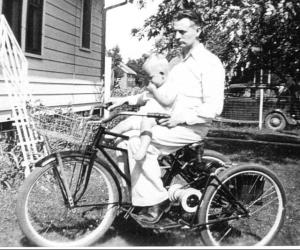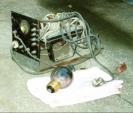| Owner | Bob Peterson |
|---|---|
| Location | Cedar Rapids, Iowa United States map |
| Vehicle | 1941 Montgomery Wards Monarch Homemade 3 wheel bike converted from a standard 2 wheel bike. |
| Motor | 1912 Dodge An original 1912 Dodge generator is used as a drive motor. |
| Drivetrain | Belt driven friction jackshaft with differential gears for each drive wheel. Has original bicycle coaster brake-not effective with added weight of electrical components. |
| Controller | Home built No standard controller is used. The batteries are connected in series and parallel to a terminal block. The actuator switch selects between 6 v or 12v connection. |
| Batteries | 2, 6.00 Volt, Lead-Acid, Flooded Two standard automotive lead acid batteries will be used in the final restoration configuration. For restoration testing, a single 6v or a single 12v battery is used. |
| System Voltage | 6 Volts |
| Charger | Home built My Father fabricated the battery charger in 1941. I have the original charger. See photo. |
| Heater | Jacket, gloves, and hat |
| DC/DC Converter | No converter is used |
| Instrumentation | None |
| Top Speed | 15 MPH (24 KPH) The bike has two speeds. Six mph on 6v and fifteen mph on 12v. |
| Acceleration | 0 - 6 mph on 6v is about 2 seconds. 0 - 12 mph on 12v is about 10 seconds. |
| Range | 25 Miles (40 Kilometers) The range driven during a test run was 25+ miles on a single deep cycle 12v battery. |
| Watt Hours/Mile | No efficiency tests have been done at this time. |
| Seating Capacity | 1 adult |
| Curb Weight | 120 Pounds (54 Kilograms) This is curb weight less rider. |
| Tires | 2.125" x 26" standard bicycle tires. There are three on the bike. Tires are inflated to approx 50 psi. |
| Conversion Time | About four months in early 1941 |
| Conversion Cost | $15. My Father worked at an electric motor shop. The material was used scrap (no cost). He designed the bike and did all of the fabrication and welding. Most of the cost was the extra bicycle wheel, used Dodge 1912 generator, belts, and two batteries. |
| Additional Features | The bike has handmade differential gears for each drive wheel. Only one wheel drives when a turn is made. The hand made double throw controlling switch has three positions. 1. Off 2. 6v position 3. 12v position. The bike starts out as 6v to 6 mph then the operator moves the switch to 12v which accelerates the bike to 15 mph. |
| My Father fabricated the bike in 1941 to beat the gas rationing of WWII. He rode in Spring, Summer, Fall during the war years. The bike has no lights and was never licenced. There was no traffic on the streets and in four years he was never stopped or questioned. The bike was ridden 2 miles to work in the morning and 2 miles back in the evening. He had a basket on the front to get groceries on his return trip. The batteries were only charged every other day. This bike was featured in an article in the April 1945 issue of Popular Science. I am 90% finished with the restoration of my Father's special WWII electric bike. How many other people created an electric vehicle during WWII to beat the gas rationing? Since the bike has been restored I talked with the Iowa DOT to see if I could license it. They said I did not qualify as a licensed vehicle due to the 15 mph top speed. What a difference 70 years makes. The bike is now 70 years old and in 2012 the Dodge generatoer will be 100 years old. It still gets with the program today when the switch is turned. My Father would be proud of all the EV projects that are being created today. He owned an electric motor business for 50 years and was a Citi-Car EV dealer in the mid 1970's | |
Copyright © 1997-2025 by Mike Chancey


